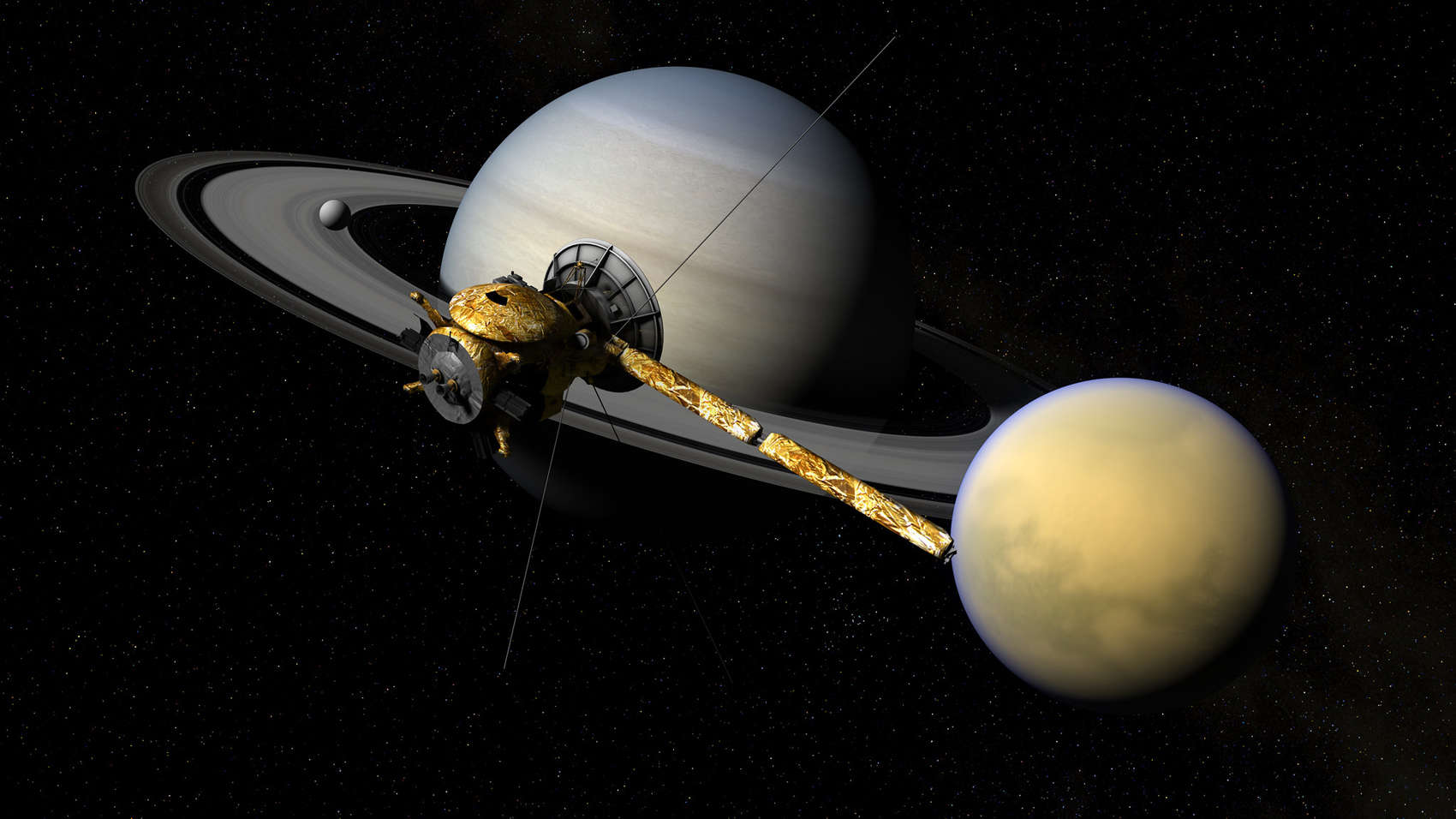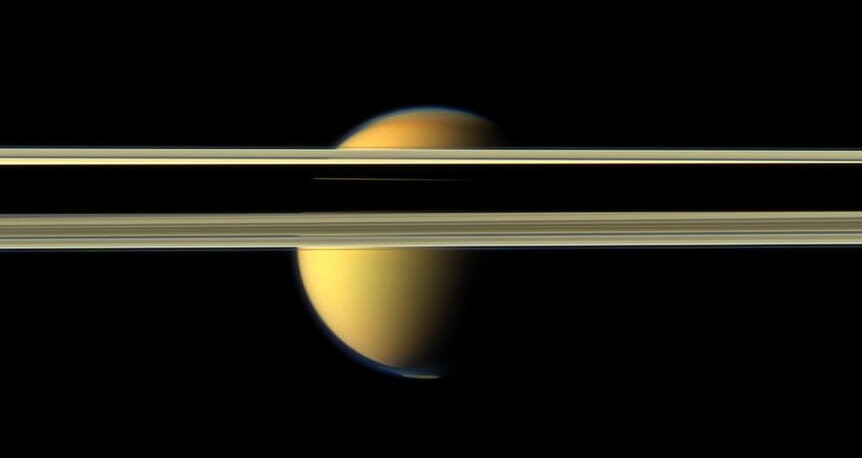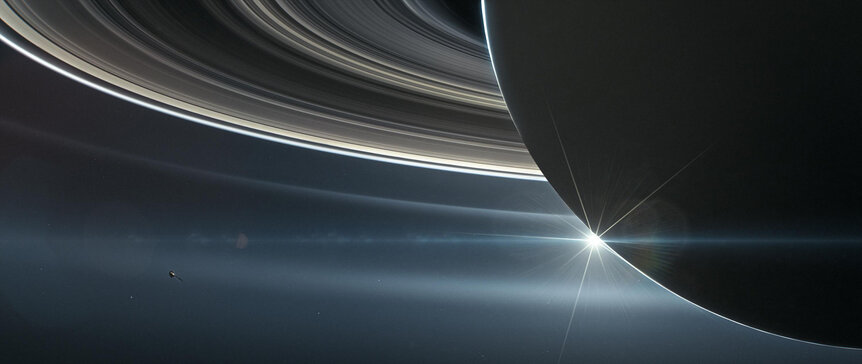Create a free profile to get unlimited access to exclusive videos, sweepstakes, and more!
Titan has had *enough* of Saturn, leaving the planet 100X faster than expected

Personally, if I were orbiting Saturn, I'd want to stick around as long as possible. But Titan, however, is not me, and is hightailing it away from the planet — receding from Saturn 100 times faster than expected.
Not that it's exactly zipping away; it's moving at 11 centimeters per year from Saturn. Your hair grows more than twice that fast. Still, at this rate, it'll leave Saturn in about 5 billion years, which on a galactic timescale is imminent.
The reason it's moving away at all is due to tides. I have an article explaining how this works in detail (and a Crash Course Astronomy episode dedicated to it as well). In a nutshell, the gravity of a moon creates a bulge in its host planet. The planet rotates rapidly, and that bulge gets carried ahead of the moon a bit. In turn, the bulge gravitationally pulls on the moon, giving it more orbital energy, which means the moon slowly moves away from the planet. This happens with our own Moon, which recedes from the Earth by about 4 cm per year.
Titan is a gigantic moon, the second largest in the solar system and almost as big as Mercury (if Saturn weren't there, we'd be tempted to call it a planet in its own right). It raises a pretty decent tidal bulge in Saturn … but in some cases this whole process depends very strongly on the distance of the moon and the planet (double the distance and things slow by a factor of nearly 50). At Titan's distance of 1.2 million km, it was thought that it would barely recede at all, only 0.1 cm per year.
But a paper came out a few years ago suggesting that things could happen a lot more quickly, and that Saturn's moons might be moving away rapidly. A team of planetary scientists detected this in some of Saturn's mid-sized moons, so they decided to take a closer look at Titan and five other larger moons (Mimas, Rhea, Tethys, Enceladus, and Dione).
For Titan they used data from the Cassini mission, which orbited the ringed planet for 13 years and passed very close to Titan well over a hundred times. Using radio data from the spacecraft, they could measure its exact position to very high accuracy, and from that determine just where Titan was.
They also used good old-fashioned astrometry; that is, Earth-based telescopic observations of the satellites (dating back to 1886!) as well as Cassini observations to measure their positions over time. Using these measurements for the moons, and combining the radio data for Titan, they were able to measure how strongly Saturn affects the moons through tides, and found that the distance is not nearly as strong a factor as thought in this case.
The very cool thing about this is that the two methods both independently agree with a hypothesis proposed in that earlier paper a few years ago. There the scientists proposed that tidal forces from the moons act differently than thought for Saturn. In most cases, the tides create friction inside of a planet, which generates heat, and this gets dissipated throughout the planet, lessening the effect. But the new idea is that Titan creates a resonance inside Saturn, pumping energy into it more efficiently — like when you pump your legs in time with your motion on a swing, moving you higher and higher with each pass. In this case, the orbital motion of Titan syncs up with motions inside Saturn, increasing the efficiency of the tidal process.
The implications of this are interesting. When it was thought that Titan didn't move out much, it was also assumed it formed pretty much at the distance from Saturn it is now. But now that we know it's moving out rapidly, that means it must have formed much closer to Saturn all those billions of years ago (assuming this resonance has acted continuously all this time). This changes how scientists understand where the moons formed, and even how Saturn's magnificent rings have formed and evolved!
More profoundly, tides affect a huge number of systems across the Universe, including binary stars, galaxies, exoplanets that orbit close to the their stars, and again the Earth and Moon. Literally, the length of our day depends on tides from the Moon: Our current rotation rate of spinning once every 24 hours used to be much faster, but the tidal process slowed the Earth's spin over time.
We understand the overall physics of how tides work, but the detailed effects can be hard to predict and determine, and this new work shows that there's still more to learn. That's cool! We're zeroing in on better understanding of the underlying mechanisms of the Universe. You might not have thought something like that would come from the Cassini mission, but in science, all the pieces have to fit together. Everything affects everything else. Even forces so small they aren't noticeable on a daily basis, but which, inexorably, build up to huge effects over time.
Why, if there's a life lesson to be taken from that, feel free to find it for yourself.
















